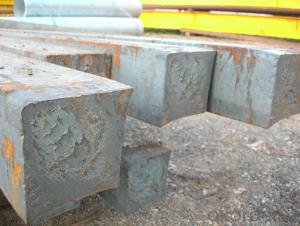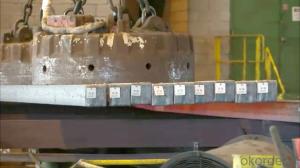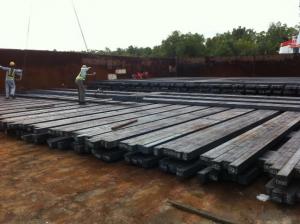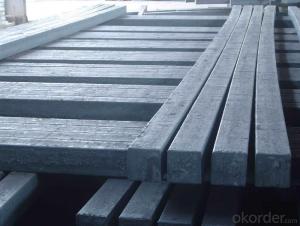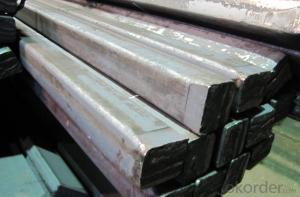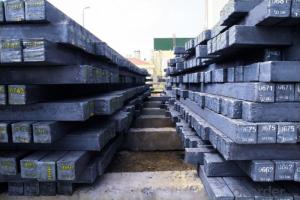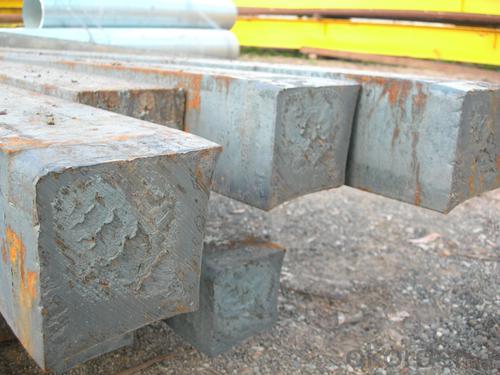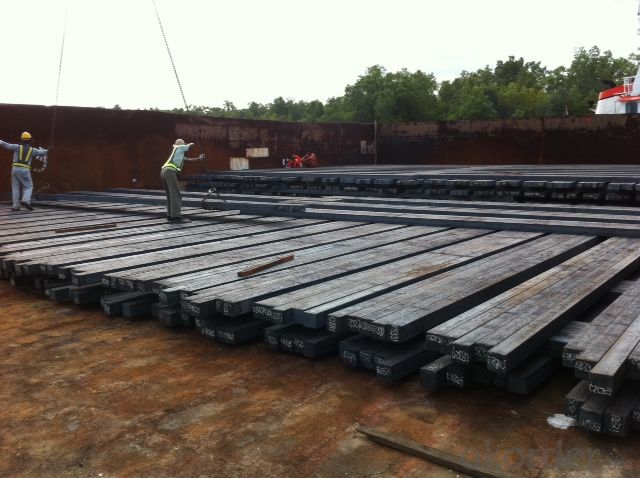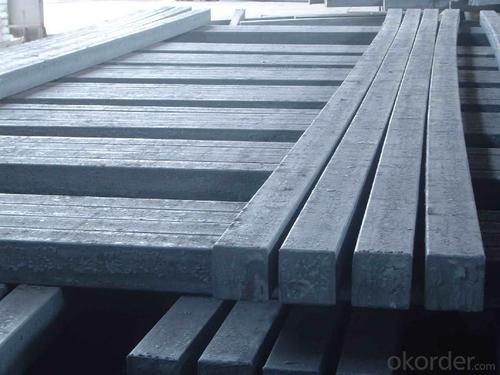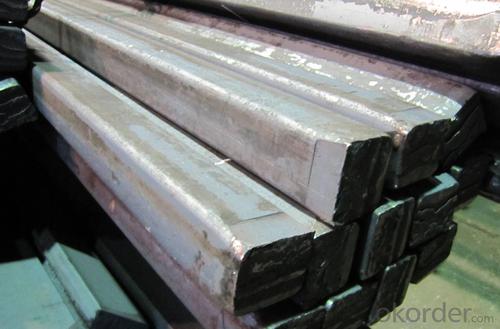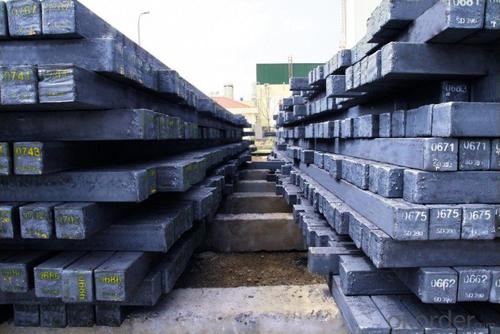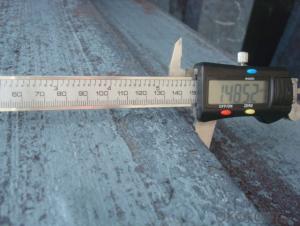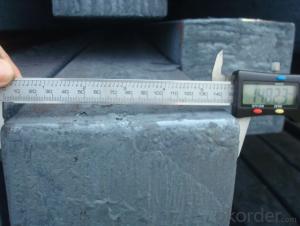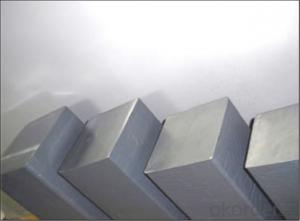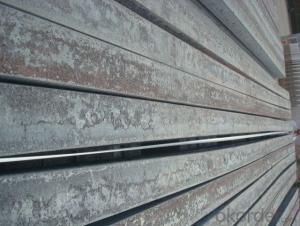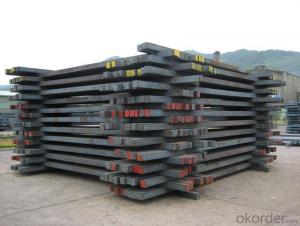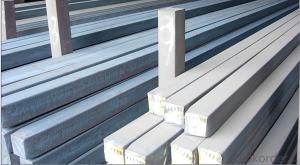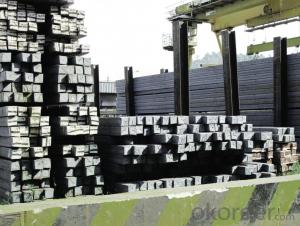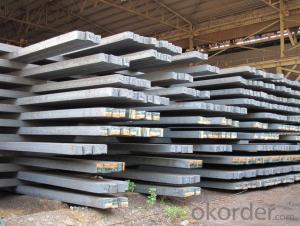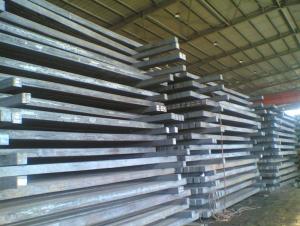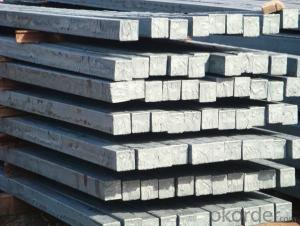Hot Rolled Square Steel Billet 3SP Standard 140mm
- Loading Port:
- Shanghai
- Payment Terms:
- TT OR LC
- Min Order Qty:
- 2000 m.t.
- Supply Capability:
- 10000 m.t./month
OKorder Service Pledge
OKorder Financial Service
You Might Also Like
Structure of Hot Rolled Square Steel Billet 3SP Standard 140mm
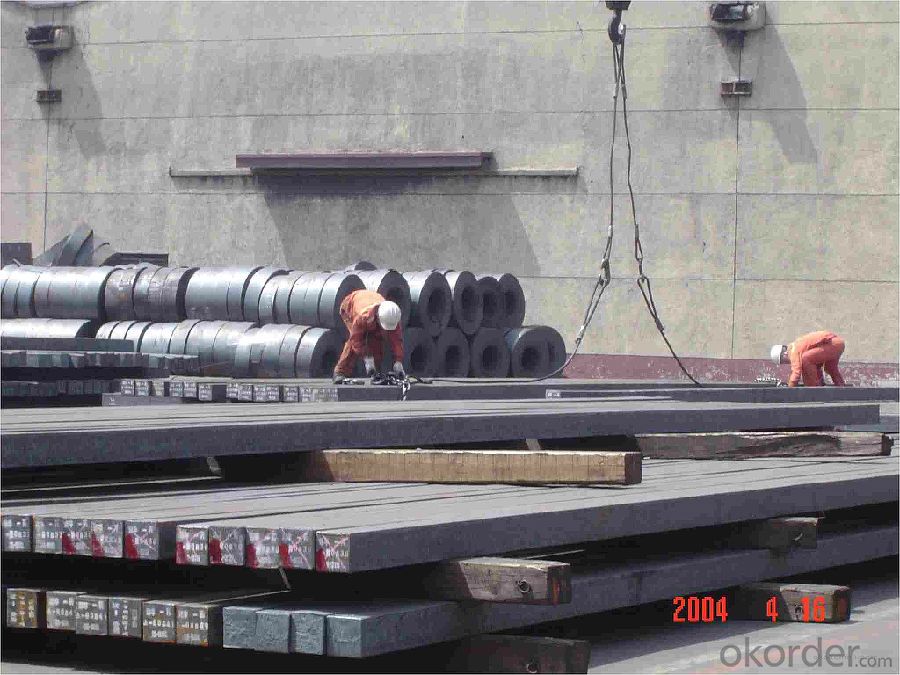
Description of Hot Rolled Square Steel Billet 3SP Standard 140mm
PPGI is made by cold rolled steel sheet and galvanized steel sheets as baseplate, through the surface pretreatment (degreasing, cleaning, chemical conversion processing), coated by the method of continuous coatings (roller coating method),
and after roasting and cooling. Zinc coating: Z60, Z80, Z100, Z120, Z180, Z275, G30, G60, G90
Alu-zinc coating: AZ60, AZ80, AZ100, AZ120, AZ180, G30, G60, G90
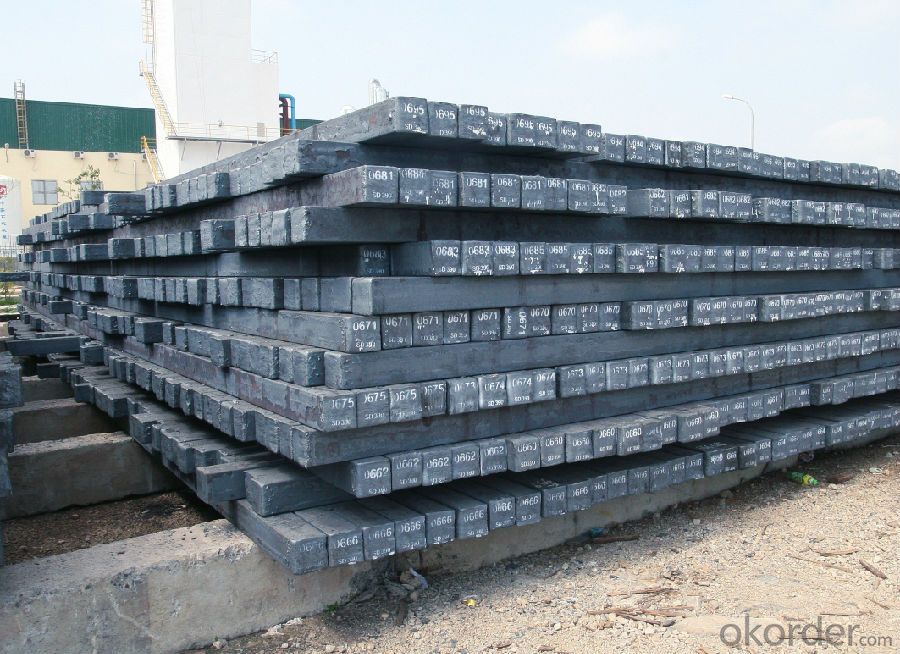
Main Feature of Hot Rolled Square Steel Billet 3SP Standard 140mm
1) Excellent corrosion resistance: The zinc layer provides a good protection of Pre-painted Galvanizeed Steel Sheet.
2) High heat resistance: The reflective surface of the material aids in efficiently reflecting the sunlight away and in turn reducing the amount of heat transmitted. The thermal reflectivity converts into energy savings.
3) Aesthetics: Pre-Painted Galvanized steel sheet is available in plethora of patterns and multiple sizes as per the requirements that given by our customers.
4) Versatility: can be used in the various areas.Standard seaworthy export packing: 3 layers of packing, inside is kraft paper, water plastic film is in the middle and outside GI steel sheet to be covered by steel strips with lock, with inner coil sleeve.
Applications of Hot Rolled Square Steel Billet 3SP Standard 140mm
1) Automotive bodies: filters, fuel tanks, etc.
2) Construction materials: roofings, welding pipes,
3) Electric and electronic appliances: computer cans, etc.
4) Steel cans: containers, etc.
5) Steel furniture: washing machines, refrigerators, microwaves, etc.
6) Drums
7) Office equipment: printer, recorders, etc.
8) Motors and transformers
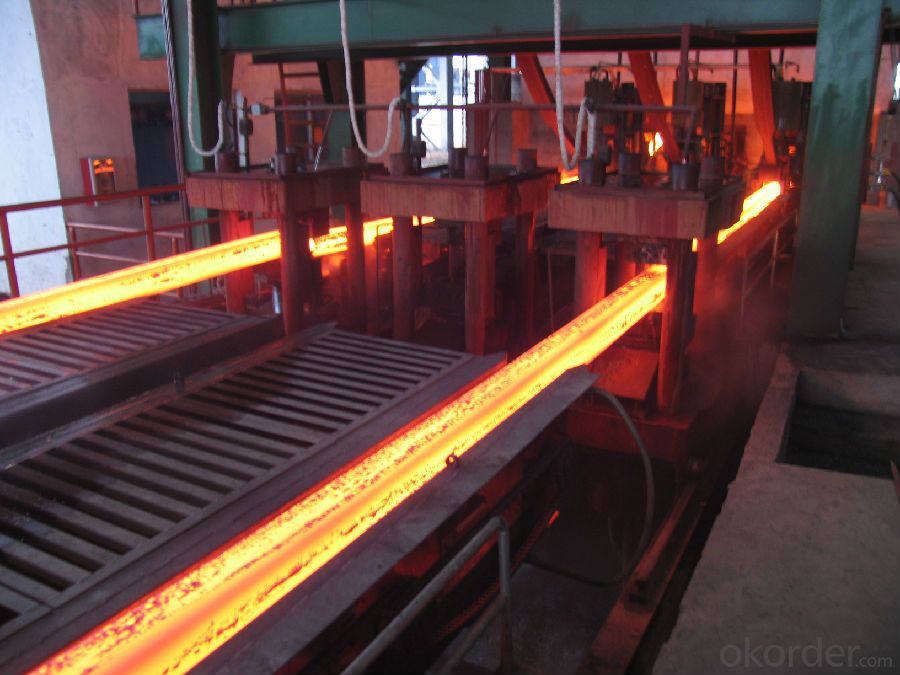
Specifications of Hot Rolled Square Steel Billet 3SP Standard 140mm
| Classified symbol | Yield Point Minimum N/mm2 | Tensile Strength Minimum | Elongation Minimum % | Application | ||||
| N/mm2 | Nominal Thickness mm (t) | |||||||
| JIS | Yogic | 0.25-0.4 | 0.4-0.6 | 0.6-1.0 | 1.0-1.6 | |||
| G3312 | specification | |||||||
| CGCC | CGCC | -205 | -270 | -20 | -21 | -24 | -24 | Commercial |
| CGCD | CGCD | --- | 270 | --- | 27 | 31 | 32 | Drawing |
| --- | CG340 | 245 | 340 | 20 | 20 | 20 | 20 | Structural |
| CGC400 | CG400 | 295 | 400 | 16 | 17 | 18 | 18 | Structural |
| CGC440 | CG440 | 335 | 440 | 14 | 15 | 16 | 18 | Structural |
| CGC490 | CG490 | 365 | 490 | 12 | 13 | 14 | 16 | Structural |
| CGC570 | CG570 | 560 | 570 | --- | --- | --- | --- | Structural |
| ASTM Designation | Yield Point Minimum | Tensile Strength Minimum | Elongation Minimum % | Application | Q/BQB 445-2004(China standard) | ASM A653/A653M | JISG 3312 | |
| ksi(MPa) | ksi(MPa) | TDC51D+Z | (CS TYPE A+Z) | CGCC | ||||
| A653(M)-99 CS TYPE A,B,C | --- | --- | --- | Commercial | TDC52D+Z | CGCD | ||
| A653(M)-99 FS | --- | --- | --- | Lock Forming | TS250GD+Z | (G250+Z) | - | |
| A653(M)-99 DS | --- | --- | --- | Drawing | TS300GS+Z | (G300+Z) | CGC 400 | |
| A653(M)-99 SS Grade33(230) | 33(230) | 45(310) | 20 | Structural | TS350GD+Z | (G350+Z) | CGC490 | |
| A653(M)-99 SS Grade37(255) | 37(255) | 52(360) | 18 | Structural | TS550GD+Z | (G550+Z) | CGC570 | |
| A653(M)-99 SS Grade40(275) | 40(275) | 55(380) | 16 | Structural | ||||
| A653(M)-99 SS Grade50(345) | 50(345) | 65(450) | 12 | Structural | ||||
| A653(M)-99 SS Grade80(550) | 80(550) | 82(570) | --- | Structural | ||||
FAQ of Hot Rolled Square Steel Billet 3SP Standard 140mm
We have organized several common questions for our clients,may help you sincerely:
1. How Can I Visit There?
Our company is located in Tianjin City, China, near Beijing. You can fly to Tianjin Airport Directly. All our clients, from home or aboard, are warmly welcome to visit us!
2. How Can I Get Some Sample?
We are honored to offer you sample.
3. Why choose CNBM?
1, ISO, BV, CE, SGS approved.
2, Competitive price and quality.
3, Efficient service team online for 24 hours.
4, Smooth production ability(50000tons/month) .
5, quick delivery and standard exporting package.
6, Flexible payment with T/T, L/C, Paypal, Kunlun bank, etc.
- Q: Can steel billets be cast from recycled steel?
- Yes, steel billets can be cast from recycled steel.
- Q: How are steel billets used in the production of steel cables?
- Steel cables require steel billets as a key component for their production. These billets act as the primary material from which the cables are made. The billets undergo a range of processes to manufacture the steel cables. Initially, the steel billets are heated in a furnace to extremely high temperatures, which makes them more pliable and easier to manipulate. This technique is referred to as annealing. Afterward, the billets are passed through a sequence of rollers to shape them into the desired form and size required for the cables. Subsequently, the shaped billets are fed through a wire drawing machine, where they are pulled through a series of dies to decrease their diameter and increase their length. This results in the formation of wire rods that resemble wires. These wire rods then undergo further processing in a series of machines to eliminate any impurities or surface defects. They are subsequently coated with lubricants to minimize friction during subsequent processes. The wire rods are then transferred to a wire stranding machine, where multiple wires are twisted together to form strands. These strands are then combined through either twisting or braiding to create the final steel cables. The cables are once again coated with lubricants to enhance their durability and resistance against corrosion. In summary, steel billets are of utmost importance in the production of steel cables, serving as the initial material for the entire manufacturing process. Through a combination of heating, shaping, and drawing processes, the billets are transformed into wire rods, which are further processed to produce the strands and ultimately the final steel cables.
- Q: What are the main factors affecting the ductility of steel billets?
- The main factors affecting the ductility of steel billets are the composition of the steel, the temperature at which it is processed, and the amount of strain applied during shaping.
- Q: Can steel billets be used in the production of automotive components?
- Yes, steel billets can be used in the production of automotive components. Steel billets are raw, semi-finished steel products that can undergo further processing, such as rolling, forging, or machining, to create various automotive parts like engine blocks, suspension components, gears, and more. The use of steel billets allows for the production of high-strength and durable automotive components, making them a popular choice in the automotive industry.
- Q: What are the advantages of using steel billets in the manufacturing process?
- Using steel billets in the manufacturing process offers numerous benefits. Firstly, the controlled casting process used to produce steel billets ensures superior quality and consistent material. This consistency is essential in manufacturing applications that demand precise dimensions and mechanical properties. Secondly, steel billets possess remarkable strength and durability, making them suitable for a wide range of manufacturing purposes. Steel is renowned for its high tensile strength, enabling it to withstand heavy loads and impacts without any deformation or failure. As a result, steel billets are ideal for structural components and machinery parts that must endure high levels of stress. Moreover, steel billets can be easily shaped and formed into various sizes and shapes to meet specific design requirements. Manufacturers can achieve the desired shape by hot rolling, cold rolling, or forging the billets. This flexibility allows for the creation of intricate and complex parts with ease. Additionally, steel billets have exceptional resistance to heat and corrosion. This makes them highly suitable for applications involving high temperatures or exposure to harsh environments, such as automotive components, construction materials, and industrial machinery. Furthermore, steel billets are readily available and cost-effective compared to alternative materials. Steel is one of the most widely produced and recycled materials globally, ensuring a consistent supply and competitive prices. This availability and affordability make steel billets the preferred choice for many manufacturers. Lastly, steel billets are environmentally friendly. The recyclability of steel helps reduce energy consumption and greenhouse gas emissions during the manufacturing process. Choosing steel billets enables businesses to minimize their environmental impact and make sustainable choices. In conclusion, the advantages of using steel billets in the manufacturing process include their superior quality and consistency, exceptional strength and durability, versatility in shaping, resistance to heat and corrosion, availability and cost-effectiveness, and environmental sustainability.
- Q: How are steel billets used in the production of turbine blades?
- Turbine blades rely heavily on steel billets, which serve as a fundamental building block in their production. These billets, essentially semi-finished steel products, serve as the initial material for the manufacturing process. To commence, the selection of steel billets is a meticulous process, taking into account specific requirements such as composition, strength, and durability. Once chosen, the billets undergo a series of processing steps to transform them into turbine blades. The initial step involves subjecting the steel billets to high temperatures in a furnace, a process known as forging. This procedure enhances the malleability of the steel, making it easier to work with. Once heated, the billets are then shaped into turbine blades through the application of mechanical forces. Following the initial forging process, the turbine blades are refined through a range of machining operations. These operations encompass precision cutting, grinding, and drilling, all aimed at achieving the desired dimensions, surface finish, and aerodynamic profiles. Aside from shaping and refinement, steel billets also play a pivotal role in strengthening and ensuring the integrity of turbine blades. Through heat treatment processes like quenching and tempering, the billets are hardened and tempered, resulting in desired mechanical properties such as high strength and resistance to fatigue. Moreover, steel billets provide the necessary material properties to withstand the harsh operating conditions of turbines. They exhibit excellent corrosion resistance, a crucial attribute for blades operating in environments with high temperatures, pressure, and moisture. In summary, steel billets are indispensable in turbine blade production as they serve as the starting material, facilitate shaping and refinement, and offer the required strength and durability for these critical components in power generation.
- Q: How do steel billets contribute to the manufacturing of telecommunications equipment?
- The manufacturing of telecommunications equipment heavily relies on steel billets as they supply the essential raw material for various components and structures. These billets, typically composed of carbon steel, act as semi-finished products that undergo further processing to achieve specific shapes and sizes required for telecommunications equipment. A significant contribution of steel billets to the manufacturing of telecommunications equipment is their role as the base material for constructing towers and masts. These structures are crucial for antenna and satellite dish installation, facilitating the transmission and reception of signals within telecommunications networks. Steel billets are shaped and welded to create robust and long-lasting towers capable of withstanding diverse environmental conditions. Furthermore, steel billets find application in the production of enclosures and cabinets housing telecommunication equipment. These enclosures safeguard the equipment against external factors like dust, moisture, and vandalism, ensuring optimal functioning and longevity. Steel billets are transformed into panels, frames, and chassis, which are then assembled to form resilient enclosures capable of enduring harsh environments. Moreover, steel billets contribute to the manufacturing of telecommunications equipment by being employed in the production of cable trays and supports. These components are essential for organizing and routing cables, providing an efficient infrastructure for telecommunications systems. Steel billets are rolled and shaped into various forms, such as channels and angles, to produce sturdy cable trays and supports capable of withstanding the weight and stress of multiple cables. Additionally, steel billets are utilized in the fabrication of connectors and brackets for telecommunications equipment. These small yet vital components establish necessary connections and provide support for different devices and modules within telecommunications systems. Steel billets are subjected to machining, drilling, and shaping processes to create reliable connectors and brackets, ensuring proper functionality and stability. In conclusion, steel billets have an indispensable role in the manufacturing of telecommunications equipment due to their provision of essential raw material for various components and structures. Their strength, durability, and versatility make them an ideal choice for creating robust and reliable equipment capable of meeting the demands of modern communication networks.
- Q: What are the main factors affecting the corrosion resistance of steel billets?
- The main factors affecting the corrosion resistance of steel billets are the composition of the steel, the presence of impurities, the surface condition, and the surrounding environment. Firstly, the composition of the steel plays a crucial role in its corrosion resistance. Stainless steels, for example, contain a high amount of chromium and other alloying elements that form a protective oxide layer on the surface, thereby providing excellent corrosion resistance. On the other hand, carbon steels have a lower resistance to corrosion due to their higher carbon content and lack of alloying elements. Secondly, the presence of impurities in the steel can significantly impact its corrosion resistance. Inclusions, such as sulfur, phosphorous, and non-metallic inclusions, can act as initiation sites for corrosion, leading to localized corrosion and reduced overall resistance. Therefore, controlling the presence and distribution of impurities during the production of steel billets is essential for enhancing corrosion resistance. Moreover, the surface condition of the steel billets plays a vital role in their corrosion resistance. A smooth and clean surface promotes the formation of a protective oxide layer that acts as a barrier against corrosive substances. Conversely, rough or contaminated surfaces can lead to accelerated corrosion due to increased surface area and potential for localized corrosion. Lastly, the surrounding environment greatly influences the corrosion resistance of steel billets. Factors such as humidity, temperature, pH, and the presence of corrosive substances like acids, salts, or pollutants can accelerate corrosion. For instance, steel billets exposed to high humidity or corrosive chemicals are more susceptible to corrosion than those in dry or less corrosive environments. In summary, the corrosion resistance of steel billets is influenced by the composition of the steel, the presence of impurities, the surface condition, and the surrounding environment. It is crucial to consider these factors during the production and handling of steel billets to ensure their long-term durability and resistance to corrosion.
- Q: How are steel billets straightened after rolling or forging?
- Steel billets may become irregular or bent after the rolling or forging process. To rectify this, several methods can be utilized depending on the size and shape of the billets. One commonly used technique is rotary straightening. In this process, the billets are passed through a series of rotating rolls or wheels that gradually exert pressure on the material, resulting in straightening. The rolls are typically positioned at different angles to evenly distribute force across the billet. This method is suitable for smaller billets or those with minor bends. For larger and thicker billets, hydraulic straightening is often employed. Controlled pressure is applied at specific points along the length of the billet using hydraulic presses or jacks. By adjusting the pressure at different points, the billet is gradually straightened. This method is more appropriate for heavier and significantly bent billets. In certain instances, heat can be used to facilitate the straightening process. Heat straightening involves heating the bent section of the billet to a specific temperature and then applying pressure to straighten it while it is still hot. This method is particularly effective for billets with substantial bends or twists. It is crucial to emphasize that the straightening process necessitates precise control and monitoring to avoid over-straightening or excessive stress on the material. Skilled operators and advanced equipment are indispensable to ensure effective straightening of the billets within the desired tolerances.
Send your message to us
Hot Rolled Square Steel Billet 3SP Standard 140mm
- Loading Port:
- Shanghai
- Payment Terms:
- TT OR LC
- Min Order Qty:
- 2000 m.t.
- Supply Capability:
- 10000 m.t./month
OKorder Service Pledge
OKorder Financial Service
Similar products
Hot products
Hot Searches
Related keywords
